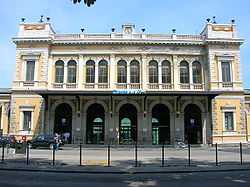Faenza railway station
| Faenza | |
 | |
|---|---|
| View of the platforms. | |
| Location | |
| Address | Piazza Cesare Battisti 6 48018 Faenza RA |
| Comune | Faenza |
| Province | Ravenna |
| Region | Emilia-Romagna |
| Country | Italy |
| Coordinates | 44°17′36″N 11°52′59″E / 44.29333°N 11.88306°ECoordinates: 44°17′36″N 11°52′59″E / 44.29333°N 11.88306°E |
| Line(s) | Bologna–Ancona Florence–Faenza Faenza–Lavezzola Faenza–Ravenna |
| Distance | 49.062 km (30.486 mi) from Bologna Centrale |
| Other information | |
| Opened | 1893 |
| Architect | Roberto Narducci |
| Rebuilt | 1948 |
| Manager | Rete Ferroviaria Italiana Centostazioni |
| Line operator(s) | Trenitalia |
| Classification | Gold |
| Services | |
| | |
| Connections | |
| Urban buses | |
| Location map | |
 Faenza railway station (Northern Italy)
| |
Faenza railway station (Italian: Stazione di Faenza) serves the city and comune of Faenza, in the region of Emilia-Romagna, northern Italy. Opened in 1893, it forms part of the Bologna–Ancona railway, and is also a terminus of two secondary railways, linking Faenza with Lavezzola and with Ravenna, and with Florence, respectively.
The station is currently managed by Rete Ferroviaria Italiana (RFI). However, the commercial area of the passenger building is managed by Centostazioni. Train services are operated by Trenitalia. Each of these companies is a subsidiary of Ferrovie dello Stato (FS), Italy's state-owned rail company.
Location
Faenza railway station is situated at Piazza Cesare Battisti, at the northern edge of the city centre.
History
Faenza's original station was opened on 1 September 1861, together with the rest of the Bologna–Forlì section of the Bologna–Ancona railway.[1] It was located to the east of the present station, near what is now Via Caldesi.[2]
In 1893, upon the inauguration of the Faentina railway to Florence, the present station was opened to replace the original station. However, the relocation of the station to a less central site necessitated the construction of a road link (Viale Alfredo Beccarini) between the city centre and the new facility. This led to the destruction of the city walls, and the distortion of the fabric of the urban village of Ganga.[2]
The 1893 passenger building was later destroyed by a bombing raid during World War II.[2] It was rebuilt in 1948 by architect Roberto Narducci, who had already rebuilt several railway stations in the post-war period.
In 2009, Centostazioni and RFI completed a general restructuring of the property and the adaptation of technological systems in accordance with legal requirements.
The proposed Metropolis project of the comune of Faenza would reclassify the space outside the station, and particularly the goods yard. It would also involve the construction of new housing estates (approximately 30,000 cubic meters in volume), and a new bus terminal and bike paths.
Features
Passenger building
The passenger building is constructed in an evidently Italian rationalist style typical of the stations designed by Narducci. It is shaped like a rectangular parallelepiped on two levels.
At ground floor level, there are two large openings with rectangular sides. Upstairs, a large window illuminates and atrium inside the building. Extending laterally from each side of the passenger building are two asymmetrical single storey buildings in brick. These house the equipment rooms and the restaurant and bar.
Beyond the outer end of each of these two buildings, there is another building on three levels, not open to travellers.
Station yard
Adjacent to the passenger building is the station yard. It has seven tracks used for passenger services. In detail:
- Track 1: on the main Faentina line, is used by Faentina line trains;
- Track 2: a loop siding, is also part of the Faentina line;
- Track 3: on the main Bologna–Ancona line, is generally used by even-numbered stopping trains (heading north);
- Track 4: also on the main Bologna–Ancona line, is generally used by odd-numbered stopping trains (southbound);
- Tracks 5, 6 and 7: are loop sidings generally used for trains terminating in Faenza, or for any overtaking.
All passenger tracks have a platform sheltered by a canopy. The platforms are connected with each other by a pedestrian underpass.
There are also other tracks (without platforms and forming a separate area with similar tracks) used for the storage of rolling stock not in service. The rolling stock stored there includes many ALn 668 1900 series railcars, and several Minuetto series diesel multiple units. Both of these types are used on the lines radiating from Faenza.
Passenger and train movements
The station has about 2.6 million passenger movements each year.[3]
The passenger trains calling at the station are regional, express, InterCity and Eurostar City services.
A total of about 140 passenger trains serve the station each day. Their main destinations are Bologna Centrale, Ancona, Rimini, Milano Centrale and Piacenza.
See also
- History of rail transport in Italy
- List of railway stations in Emilia-Romagna
- Rail transport in Italy
- Railway stations in Italy
References
- ↑ Alessandro Tuzza and others. "Prospetto cronologico dei tratti di ferrovia aperti all'esercizio dal 1839 al 31 dicembre 1926" [Chronological overview of the features of the railways opened between 1839 and 31 December 1926]. Trenidicarta.it. Alessandro Tuzza. Retrieved 19 January 2011. (Italian)
- ↑ 2.0 2.1 2.2 "Faenza Railway Station". Terre di Faenza website. Terre di Faenza. Retrieved 20 January 2011. (English)
- ↑ "Flussi Annui nelle 103 Stazioni" [Annual flows at the 103 stations]. Centostazioni website. Centostazioni. Retrieved 4 December 2010. (Italian)
External links
![]() Media related to Faenza railway station at Wikimedia Commons
Media related to Faenza railway station at Wikimedia Commons
This article is based upon a translation of the Italian language version as at January 2011.
| |||||||||||||
